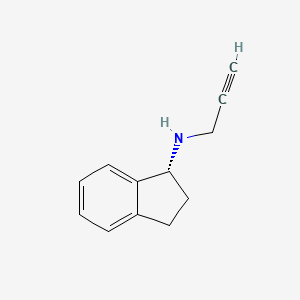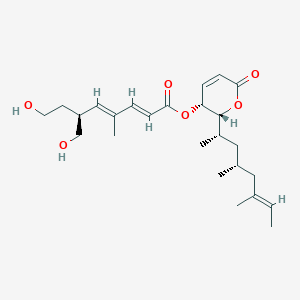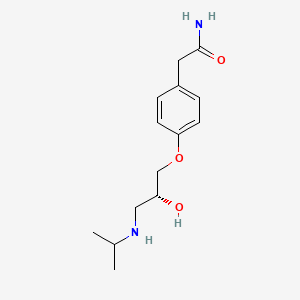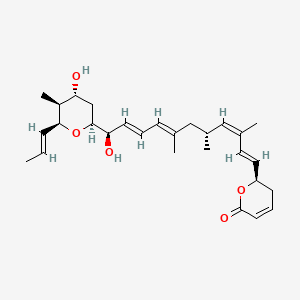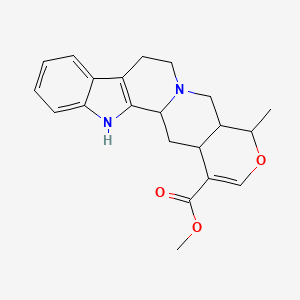
ニロチニブ
概要
説明
ニロチニブは、フィラデルフィア染色体陽性の慢性骨髄性白血病(CML)の治療に主に使用される第2世代チロシンキナーゼ阻害剤です。タシグナというブランド名で販売されています。 ニロチニブは、フィラデルフィア染色体異常によって生成され、白血病細胞の制御不能な増殖の原因となるBCR-ABLチロシンキナーゼを阻害することによって機能します .
作用機序
ニロチニブは、BCR-ABLチロシンキナーゼ、c-KIT、および血小板由来成長因子受容体(PDGFR)を選択的に阻害することによって、その効果を発揮します . BCR-ABLのATP結合部位に結合し、そのチロシンキナーゼ活性を阻害することで、細胞増殖と生存に関与する下流シグナル伝達経路のリン酸化と活性化を防ぎます。 ニロチニブは、別のチロシンキナーゼ阻害剤であるイマチニブに耐性のある慢性骨髄性白血病の場合に特に効果的です .
科学的研究の応用
Nilotinib has a wide range of scientific research applications, particularly in the fields of chemistry, biology, medicine, and industry. In medicine, nilotinib is used to treat chronic myeloid leukemia by inhibiting the BCR-ABL tyrosine kinase activity and preventing the proliferation of leukemic cells . Additionally, nilotinib analogues have been synthesized and evaluated for their antiplatelet activity and functionality towards cancer cell proliferation . In chemistry, nilotinib is used as a model compound for studying the synthesis and characterization of tyrosine kinase inhibitors. In industry, nilotinib is used in the development of new pharmaceutical formulations and drug delivery systems .
準備方法
ニロチニブは、さまざまな方法で合成できます。一般的な合成経路の1つは、式(IV)の化合物をニロチニブの塩酸塩に変換することです。 このプロセスには、最終生成物の安定性と純度を確保するために、特定の試薬と条件を使用することが含まれます . 別の方法には、ニロチニブ塩酸塩を薬学的に許容される賦形剤とともに圧縮することにより、ニロチニブの乾式造粒製剤を調製することが含まれます . さらに、ナノ調製法には、安定なナノ薬スラリーを作成するために、N、N-ジメチルホルムアミドとポリビニルピロリドンを使用し、それを噴霧乾燥して最終生成物を得ることが含まれます .
化学反応の分析
ニロチニブは、酸化、還元、置換など、さまざまな化学反応を受けます。これらの反応で使用される一般的な試薬には、酸化剤、還元剤、求核剤が含まれます。 たとえば、ニロチニブは、ネイティブケミカルリゲーション(NCL)化学を用いて、水中でベンザニリド形成を介して合成できます . この方法には、ベンゾイルとメルカプトアニリンのフラグメントを結合させて芳香族アミド結合を形成することが含まれます。これらの反応から生成される主な生成物には、潜在的な治療用途を持つニロチニブのさまざまな誘導体が含まれます。
科学研究アプリケーション
ニロチニブは、化学、生物学、医学、産業の分野で、幅広い科学研究用途を持っています。 医学では、ニロチニブは、BCR-ABLチロシンキナーゼ活性を阻害し、白血病細胞の増殖を防ぐことによって、慢性骨髄性白血病の治療に使用されます . さらに、ニロチニブ類似体は、抗血小板活性とがん細胞増殖に対する機能性について合成され、評価されています . 化学では、ニロチニブは、チロシンキナーゼ阻害剤の合成と特性評価を研究するためのモデル化合物として使用されています。 業界では、ニロチニブは、新しい製剤の開発と薬物送達システムに使用されています .
類似化合物との比較
ニロチニブは、イマチニブやダサチニブなどの他のチロシンキナーゼ阻害剤と比較されることがよくあります。 イマチニブは、慢性骨髄性白血病の治療のために承認された最初のチロシンキナーゼ阻害剤でしたが、ニロチニブとダサチニブは、効力と安全性プロファイルが向上した第2世代の阻害剤です . ニロチニブは、BCR-ABLチロシンキナーゼに対する結合親和性が高く、イマチニブと比較して、より広範囲のBCR-ABL変異に対して効果的です . 一方、ダサチニブは、ニロチニブとは構造的に異なり、BCR-ABLキナーゼドメイン変異に対する活性のスペクトルが異なります . 他の類似化合物には、ニロチニブとダサチニブの両方に耐性のあるT315I変異に対して効果的なポナチニブが含まれます .
特性
IUPAC Name |
4-methyl-N-[3-(4-methylimidazol-1-yl)-5-(trifluoromethyl)phenyl]-3-[(4-pyridin-3-ylpyrimidin-2-yl)amino]benzamide | |
|---|---|---|
| Source | PubChem | |
| URL | https://pubchem.ncbi.nlm.nih.gov | |
| Description | Data deposited in or computed by PubChem | |
InChI |
InChI=1S/C28H22F3N7O/c1-17-5-6-19(10-25(17)37-27-33-9-7-24(36-27)20-4-3-8-32-14-20)26(39)35-22-11-21(28(29,30)31)12-23(13-22)38-15-18(2)34-16-38/h3-16H,1-2H3,(H,35,39)(H,33,36,37) | |
| Source | PubChem | |
| URL | https://pubchem.ncbi.nlm.nih.gov | |
| Description | Data deposited in or computed by PubChem | |
InChI Key |
HHZIURLSWUIHRB-UHFFFAOYSA-N | |
| Source | PubChem | |
| URL | https://pubchem.ncbi.nlm.nih.gov | |
| Description | Data deposited in or computed by PubChem | |
Canonical SMILES |
CC1=C(C=C(C=C1)C(=O)NC2=CC(=CC(=C2)C(F)(F)F)N3C=C(N=C3)C)NC4=NC=CC(=N4)C5=CN=CC=C5 | |
| Source | PubChem | |
| URL | https://pubchem.ncbi.nlm.nih.gov | |
| Description | Data deposited in or computed by PubChem | |
Molecular Formula |
C28H22F3N7O | |
| Source | PubChem | |
| URL | https://pubchem.ncbi.nlm.nih.gov | |
| Description | Data deposited in or computed by PubChem | |
DSSTOX Substance ID |
DTXSID5042663 | |
| Record name | Nilotinib | |
| Source | EPA DSSTox | |
| URL | https://comptox.epa.gov/dashboard/DTXSID5042663 | |
| Description | DSSTox provides a high quality public chemistry resource for supporting improved predictive toxicology. | |
Molecular Weight |
529.5 g/mol | |
| Source | PubChem | |
| URL | https://pubchem.ncbi.nlm.nih.gov | |
| Description | Data deposited in or computed by PubChem | |
Physical Description |
Solid | |
| Record name | Nilotinib | |
| Source | Human Metabolome Database (HMDB) | |
| URL | http://www.hmdb.ca/metabolites/HMDB0015595 | |
| Description | The Human Metabolome Database (HMDB) is a freely available electronic database containing detailed information about small molecule metabolites found in the human body. | |
| Explanation | HMDB is offered to the public as a freely available resource. Use and re-distribution of the data, in whole or in part, for commercial purposes requires explicit permission of the authors and explicit acknowledgment of the source material (HMDB) and the original publication (see the HMDB citing page). We ask that users who download significant portions of the database cite the HMDB paper in any resulting publications. | |
Solubility |
The solubility ... in aqueous solutions decreases with increasing pH, 2.01e-03 g/L | |
| Record name | Nilotinib | |
| Source | Hazardous Substances Data Bank (HSDB) | |
| URL | https://pubchem.ncbi.nlm.nih.gov/source/hsdb/7842 | |
| Description | The Hazardous Substances Data Bank (HSDB) is a toxicology database that focuses on the toxicology of potentially hazardous chemicals. It provides information on human exposure, industrial hygiene, emergency handling procedures, environmental fate, regulatory requirements, nanomaterials, and related areas. The information in HSDB has been assessed by a Scientific Review Panel. | |
| Record name | Nilotinib | |
| Source | Human Metabolome Database (HMDB) | |
| URL | http://www.hmdb.ca/metabolites/HMDB0015595 | |
| Description | The Human Metabolome Database (HMDB) is a freely available electronic database containing detailed information about small molecule metabolites found in the human body. | |
| Explanation | HMDB is offered to the public as a freely available resource. Use and re-distribution of the data, in whole or in part, for commercial purposes requires explicit permission of the authors and explicit acknowledgment of the source material (HMDB) and the original publication (see the HMDB citing page). We ask that users who download significant portions of the database cite the HMDB paper in any resulting publications. | |
Mechanism of Action |
Chronic myelogenous leukaemia (CML) is caused by the BCR-ABL oncogene. Nilotinib inhibits the tyrosine kinase activity of the BCR-ABL protein. Nilotinib fits into the ATP-binding site of the BCR-ABL protein with higher affinity than imatinib, over-riding resistance caused by mutations. The ability of AMN107 to inhibit TEL-platelet-derived growth factor receptor-beta (TEL-PDGFRbeta), which causes chronic myelomonocytic leukaemia, and FIP1-like-1-PDGFRalpha, which causes hypereosinophilic syndrome, suggests potential use of AMN107 for myeloproliferative diseases characterised by these kinase fusions (Stover et al, 2005; Weisberg et al, 2005). AMN107 also inhibits the c-Kit receptor kinase, including the D816V-mutated variant of KIT, at pharmacologically achievable concentrations, supporting potential utility in the treatment of mastocytosis, and gastrointestinal stromal tumours (Weisberg et al, 2005; von Bubnoff et al, 2005; Gleixner et al, 2006)., Nilotinib, an inhibitor of Bcr-Abl tyrosine kinase, is an antineoplastic agent. Chronic myelogenous leukemia (CML) is a clonal myeloproliferative disorder characterized by the expansion of hematopoietic cells carrying the Philadelphia chromosome (Ph), resulting from a reciprocal translocation of the long arms of chromosomes 9 and 22. A novel fusion gene is formed, Bcr-Abl, which encodes a constitutively active, cytoplasmic form of protein tyrosine kinase. The unregulated activity of the Abl tyrosine kinase in Bcr-Abl is the cause of CML. Nilotinib is an orally active aminopyrimidine-derivative tyrosine kinase inhibitor that functions through competitive inhibition at the ATP-binding site of Bcr-Abl, leading to the inhibition of tyrosine phosphorylation of proteins that are involved in the intracellular signal transduction that Bcr-Abl mediates., Clinical resistance to imatinib in CML has been attributed to several mechanisms, but point mutations in the Bcr-Abl kinase domain appear to the most common, occurring in 30-90% of patients who develop resistance. The ability of nilotinib to overcome imatinib resistance resulting from Bcr-Abl kinase domain mutations has been demonstrated in vitro. In preclinical studies in cell-line models, nilotinib inhibited most (32 of 33) imatinib-resistant Bcr-Abl kinase domain mutant forms., Nilotinib binds to and stabilizes the inactive conformation of the kinase domain of Abl protein. In vitro, nilotinib inhibited Bcr-Abl mediated proliferation of murine leukemic cell lines and human cell lines derived from patients with Ph+ CML. Under the conditions of the assays, nilotinib was able to overcome imatinib resistance resulting from Bcr-Abl kinase mutations, in 32 out of 33 mutations tested. In vivo, nilotinib reduced the tumor size in a murine Bcr-Abl xenograft model. Nilotinib inhibited the autophosphorylation of the following kinases at IC50 values as indicated: Bcr-Abl (20-60 nM), PDGFR (69 nM), c-Kit (210 nM), CSF-1R (125-250 nM) and DDR (3.7 nM)., It is an important challenge to better understand the mechanisms of tyrosine kinase inhibitors-induced apoptosis in CML cells. Thus, /the authors/ have investigated how this apoptosis can be modulated by extracellular factors. Apoptosis induced by imatinib and nilotinib was determined in BCR-ABL expressing cell lines and primary CML CD34+ cells. Both molecules induced apoptosis of BCR-ABL expressing cells. This apoptosis was inhibited by protein synthesis inhibition in both K562 and CML CD34+ cells. In K562, 80% inhibition of the BCR-ABL auto-phosphorylation by either imatinib or nilotinib induced a two fold increase in Bim-EL expression and induction of apoptosis in 48 hr. Bim accumulation preceded apoptosis induction which was completely abolished by depletion in Bim using shRNA. However, the anti-proliferative effect of imatinib was preserved in Bim-depleted cells. When K562 cells were cultured in a cytokine containing medium, the pro-apoptotic effect of nilotinib was decreased by 68% and this was related to a decrease in Bim-EL dephosphorylation and accumulation. Similarly, the presence of a combination of cytokines inhibited 88% of NIL- and 39% of IMA-induced apoptosis in primary CML CD34+ cells. In conclusion, both nilotinib and imatinib induce apoptosis through Bim accumulation independently of cell cycle arrest. However, the pro-apoptotic effect of both molecules can be attenuated by the presence of cytokines and growth factors, particularly concerning nilotinib. Thus BCR-ABL inhibition restores the cytokine dependence but is not sufficient to induce apoptosis when other signaling pathways are activated., For more Mechanism of Action (Complete) data for Nilotinib (7 total), please visit the HSDB record page. | |
| Record name | Nilotinib | |
| Source | DrugBank | |
| URL | https://www.drugbank.ca/drugs/DB04868 | |
| Description | The DrugBank database is a unique bioinformatics and cheminformatics resource that combines detailed drug (i.e. chemical, pharmacological and pharmaceutical) data with comprehensive drug target (i.e. sequence, structure, and pathway) information. | |
| Explanation | Creative Common's Attribution-NonCommercial 4.0 International License (http://creativecommons.org/licenses/by-nc/4.0/legalcode) | |
| Record name | Nilotinib | |
| Source | Hazardous Substances Data Bank (HSDB) | |
| URL | https://pubchem.ncbi.nlm.nih.gov/source/hsdb/7842 | |
| Description | The Hazardous Substances Data Bank (HSDB) is a toxicology database that focuses on the toxicology of potentially hazardous chemicals. It provides information on human exposure, industrial hygiene, emergency handling procedures, environmental fate, regulatory requirements, nanomaterials, and related areas. The information in HSDB has been assessed by a Scientific Review Panel. | |
Color/Form |
White to slightly yellowish to slightly greenish yellow powder | |
CAS No. |
641571-10-0, 923288-90-8 | |
| Record name | Nilotinib | |
| Source | CAS Common Chemistry | |
| URL | https://commonchemistry.cas.org/detail?cas_rn=641571-10-0 | |
| Description | CAS Common Chemistry is an open community resource for accessing chemical information. Nearly 500,000 chemical substances from CAS REGISTRY cover areas of community interest, including common and frequently regulated chemicals, and those relevant to high school and undergraduate chemistry classes. This chemical information, curated by our expert scientists, is provided in alignment with our mission as a division of the American Chemical Society. | |
| Explanation | The data from CAS Common Chemistry is provided under a CC-BY-NC 4.0 license, unless otherwise stated. | |
| Record name | Nilotinib [USAN:INN:BAN] | |
| Source | ChemIDplus | |
| URL | https://pubchem.ncbi.nlm.nih.gov/substance/?source=chemidplus&sourceid=0641571100 | |
| Description | ChemIDplus is a free, web search system that provides access to the structure and nomenclature authority files used for the identification of chemical substances cited in National Library of Medicine (NLM) databases, including the TOXNET system. | |
| Record name | Nilotinib | |
| Source | DrugBank | |
| URL | https://www.drugbank.ca/drugs/DB04868 | |
| Description | The DrugBank database is a unique bioinformatics and cheminformatics resource that combines detailed drug (i.e. chemical, pharmacological and pharmaceutical) data with comprehensive drug target (i.e. sequence, structure, and pathway) information. | |
| Explanation | Creative Common's Attribution-NonCommercial 4.0 International License (http://creativecommons.org/licenses/by-nc/4.0/legalcode) | |
| Record name | Nilotinib | |
| Source | DTP/NCI | |
| URL | https://dtp.cancer.gov/dtpstandard/servlet/dwindex?searchtype=NSC&outputformat=html&searchlist=747599 | |
| Description | The NCI Development Therapeutics Program (DTP) provides services and resources to the academic and private-sector research communities worldwide to facilitate the discovery and development of new cancer therapeutic agents. | |
| Explanation | Unless otherwise indicated, all text within NCI products is free of copyright and may be reused without our permission. Credit the National Cancer Institute as the source. | |
| Record name | Nilotinib | |
| Source | EPA DSSTox | |
| URL | https://comptox.epa.gov/dashboard/DTXSID5042663 | |
| Description | DSSTox provides a high quality public chemistry resource for supporting improved predictive toxicology. | |
| Record name | 4-methyl-N-[3-(4-methyl-1H-imidazol-1-yl)-5-(trifluoromethyl)phenyl]-3-{[4-(pyridin-3-yl)pyrimidin-2-yl]amino}benzamide | |
| Source | European Chemicals Agency (ECHA) | |
| URL | https://echa.europa.eu/substance-information/-/substanceinfo/100.166.395 | |
| Description | The European Chemicals Agency (ECHA) is an agency of the European Union which is the driving force among regulatory authorities in implementing the EU's groundbreaking chemicals legislation for the benefit of human health and the environment as well as for innovation and competitiveness. | |
| Explanation | Use of the information, documents and data from the ECHA website is subject to the terms and conditions of this Legal Notice, and subject to other binding limitations provided for under applicable law, the information, documents and data made available on the ECHA website may be reproduced, distributed and/or used, totally or in part, for non-commercial purposes provided that ECHA is acknowledged as the source: "Source: European Chemicals Agency, http://echa.europa.eu/". Such acknowledgement must be included in each copy of the material. ECHA permits and encourages organisations and individuals to create links to the ECHA website under the following cumulative conditions: Links can only be made to webpages that provide a link to the Legal Notice page. | |
| Record name | 4-Methyl-N-(3-(4-methyl-1H-imidazol-1-yl)-5-(trifluoromethyl)-phenyl)-3-((4-(pyridin-3-yl)pyrimidin-2-yl)amino)benzamide | |
| Source | European Chemicals Agency (ECHA) | |
| URL | https://echa.europa.eu/information-on-chemicals | |
| Description | The European Chemicals Agency (ECHA) is an agency of the European Union which is the driving force among regulatory authorities in implementing the EU's groundbreaking chemicals legislation for the benefit of human health and the environment as well as for innovation and competitiveness. | |
| Explanation | Use of the information, documents and data from the ECHA website is subject to the terms and conditions of this Legal Notice, and subject to other binding limitations provided for under applicable law, the information, documents and data made available on the ECHA website may be reproduced, distributed and/or used, totally or in part, for non-commercial purposes provided that ECHA is acknowledged as the source: "Source: European Chemicals Agency, http://echa.europa.eu/". Such acknowledgement must be included in each copy of the material. ECHA permits and encourages organisations and individuals to create links to the ECHA website under the following cumulative conditions: Links can only be made to webpages that provide a link to the Legal Notice page. | |
| Record name | NILOTINIB | |
| Source | FDA Global Substance Registration System (GSRS) | |
| URL | https://gsrs.ncats.nih.gov/ginas/app/beta/substances/F41401512X | |
| Description | The FDA Global Substance Registration System (GSRS) enables the efficient and accurate exchange of information on what substances are in regulated products. Instead of relying on names, which vary across regulatory domains, countries, and regions, the GSRS knowledge base makes it possible for substances to be defined by standardized, scientific descriptions. | |
| Explanation | Unless otherwise noted, the contents of the FDA website (www.fda.gov), both text and graphics, are not copyrighted. They are in the public domain and may be republished, reprinted and otherwise used freely by anyone without the need to obtain permission from FDA. Credit to the U.S. Food and Drug Administration as the source is appreciated but not required. | |
| Record name | Nilotinib | |
| Source | Hazardous Substances Data Bank (HSDB) | |
| URL | https://pubchem.ncbi.nlm.nih.gov/source/hsdb/7842 | |
| Description | The Hazardous Substances Data Bank (HSDB) is a toxicology database that focuses on the toxicology of potentially hazardous chemicals. It provides information on human exposure, industrial hygiene, emergency handling procedures, environmental fate, regulatory requirements, nanomaterials, and related areas. The information in HSDB has been assessed by a Scientific Review Panel. | |
| Record name | Nilotinib | |
| Source | Human Metabolome Database (HMDB) | |
| URL | http://www.hmdb.ca/metabolites/HMDB0015595 | |
| Description | The Human Metabolome Database (HMDB) is a freely available electronic database containing detailed information about small molecule metabolites found in the human body. | |
| Explanation | HMDB is offered to the public as a freely available resource. Use and re-distribution of the data, in whole or in part, for commercial purposes requires explicit permission of the authors and explicit acknowledgment of the source material (HMDB) and the original publication (see the HMDB citing page). We ask that users who download significant portions of the database cite the HMDB paper in any resulting publications. | |
Synthesis routes and methods I
Procedure details








Synthesis routes and methods II
Procedure details







Synthesis routes and methods III
Procedure details





Synthesis routes and methods IV
Procedure details











Retrosynthesis Analysis
AI-Powered Synthesis Planning: Our tool employs the Template_relevance Pistachio, Template_relevance Bkms_metabolic, Template_relevance Pistachio_ringbreaker, Template_relevance Reaxys, Template_relevance Reaxys_biocatalysis model, leveraging a vast database of chemical reactions to predict feasible synthetic routes.
One-Step Synthesis Focus: Specifically designed for one-step synthesis, it provides concise and direct routes for your target compounds, streamlining the synthesis process.
Accurate Predictions: Utilizing the extensive PISTACHIO, BKMS_METABOLIC, PISTACHIO_RINGBREAKER, REAXYS, REAXYS_BIOCATALYSIS database, our tool offers high-accuracy predictions, reflecting the latest in chemical research and data.
Strategy Settings
| Precursor scoring | Relevance Heuristic |
|---|---|
| Min. plausibility | 0.01 |
| Model | Template_relevance |
| Template Set | Pistachio/Bkms_metabolic/Pistachio_ringbreaker/Reaxys/Reaxys_biocatalysis |
| Top-N result to add to graph | 6 |
Feasible Synthetic Routes
Q1: How does Nilotinib interact with its target, and what are the downstream effects of this interaction?
A1: Nilotinib functions as a potent and selective inhibitor of the Bcr-Abl tyrosine kinase, a constitutively active kinase arising from the Philadelphia chromosome translocation found in chronic myeloid leukemia (CML). [, , ] It exerts its effect by competitively binding to the ATP-binding site of Bcr-Abl, thereby inhibiting tyrosine phosphorylation of downstream signaling proteins. [, ] This blockage disrupts critical pathways like JAK-STAT, cell cycle progression, and ABC transporter activity, ultimately leading to the inhibition of proliferation and induction of apoptosis in Bcr-Abl-expressing cells. [, , ]
Q2: What is the molecular formula and weight of Nilotinib?
A2: The molecular formula of Nilotinib is C28H22F3N7O, and its molecular weight is 539.5 g/mol. []
Q3: Is there any spectroscopic data available for Nilotinib?
A3: While the provided research papers don't delve into detailed spectroscopic characterization, high-performance liquid chromatography is mentioned as a technique for measuring Nilotinib plasma trough concentrations. []
Q4: What evidence supports the efficacy of Nilotinib in treating CML?
A4: Numerous studies highlight Nilotinib's efficacy in treating CML. Clinical trials like ENESTnd demonstrate its superiority over Imatinib in achieving higher rates of cytogenetic and molecular responses in newly diagnosed CML patients. [, , ] Further evidence stems from Phase II trials showcasing its effectiveness in Imatinib-resistant or -intolerant CML patients, achieving significant hematologic and cytogenetic responses. [, , ]
Q5: Are there any in vitro studies that support Nilotinib's efficacy?
A5: Yes, in vitro studies using CML cell lines like K562 reveal Nilotinib's potent inhibitory effects. It effectively inhibits Bcr-Abl autophosphorylation and proliferation at significantly lower concentrations compared to Imatinib, indicating its higher potency. [] Moreover, it effectively suppresses CML progenitor cell growth, primarily by inhibiting cell division. []
Q6: What are the known mechanisms of resistance to Nilotinib in CML?
A6: Despite its efficacy, resistance to Nilotinib can arise through various mechanisms. One major contributor is the emergence of mutations within the Bcr-Abl kinase domain, such as the T315I mutation, which hinders Nilotinib binding. [, , , ] Other mechanisms include overexpression of anti-apoptotic proteins like BCL2 and upregulation of drug efflux pumps like MRP1, contributing to decreased intracellular drug concentrations. []
Q7: Does cross-resistance exist between Nilotinib and other TKIs like Imatinib or Dasatinib?
A7: Yes, cross-resistance can occur, particularly with mutations in the Bcr-Abl kinase domain. While Nilotinib demonstrates efficacy against many Imatinib-resistant mutations, certain mutations, like T315I, confer resistance to both. [, , , ] Interestingly, Dasatinib, due to its distinct binding mechanism, retains efficacy against some Nilotinib-resistant mutations, including those affecting the F359 residue. []
Q8: Does Nilotinib interact with drug transporters?
A9: Yes, research indicates that Nilotinib interacts with the ABCB1 (MDR1) transporter, a drug efflux pump. [] This interaction can potentially impact its tissue distribution and efficacy, as ABCB1 actively transports substrates out of cells. []
Q9: What is the safety profile of Nilotinib, and are there any potential long-term effects?
A10: While generally well-tolerated, Nilotinib can cause adverse effects. Common side effects include rash, nausea, pruritus, and hematological abnormalities like neutropenia and thrombocytopenia. [, , ] Additionally, it has been linked to metabolic changes, including hyperglycemia, hyperlipidemia, and an increased risk of arterial occlusive events like peripheral artery disease. [, , ] Long-term use necessitates careful monitoring for these potential complications.
Q10: Are there any strategies to improve Nilotinib delivery to specific targets or tissues?
A10: While the provided research papers primarily focus on Nilotinib's systemic administration, future research could explore targeted delivery strategies. Nanocarrier-based drug delivery systems, for instance, hold potential for enhancing its accumulation in specific tissues like the bone marrow, potentially improving efficacy and minimizing off-target effects.
Q11: What biomarkers are being investigated for predicting Nilotinib efficacy or monitoring treatment response?
A12: Monitoring BCR-ABL transcript levels via RT-PCR serves as a crucial biomarker for assessing treatment response and identifying potential resistance. [, , , ] Achieving deep molecular responses, like MR4.5 (BCR-ABL ≤ 0.0032%IS), is associated with favorable outcomes. [, ] Additionally, plasma trough concentrations of Nilotinib have been correlated with molecular response, suggesting a potential role in treatment optimization. []
試験管内研究製品の免責事項と情報
BenchChemで提示されるすべての記事および製品情報は、情報提供を目的としています。BenchChemで購入可能な製品は、生体外研究のために特別に設計されています。生体外研究は、ラテン語の "in glass" に由来し、生物体の外で行われる実験を指します。これらの製品は医薬品または薬として分類されておらず、FDAから任何の医療状態、病気、または疾患の予防、治療、または治癒のために承認されていません。これらの製品を人間または動物に体内に導入する形態は、法律により厳格に禁止されています。これらのガイドラインに従うことは、研究と実験において法的および倫理的な基準の遵守を確実にするために重要です。

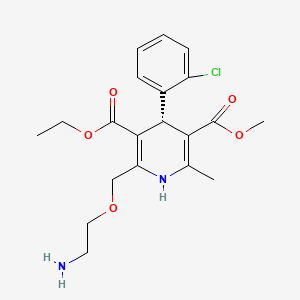
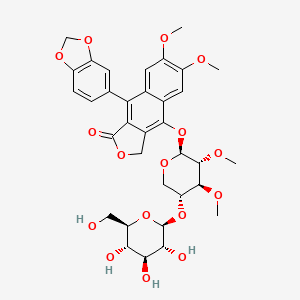

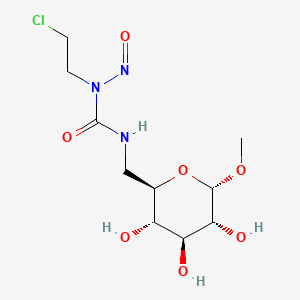

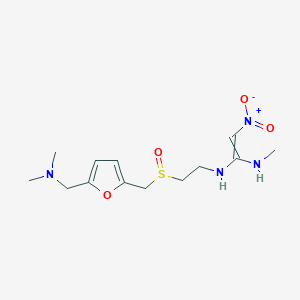

![N-(1,5-dimethyl-3-oxo-2-phenyl-2,3-dihydro-1H-pyrazol-4-yl)nicotinamide (7,7-dimethyl-2-oxobicyclo[2.2.1]heptan-1-yl)methanesulfonate](/img/structure/B1678813.png)
